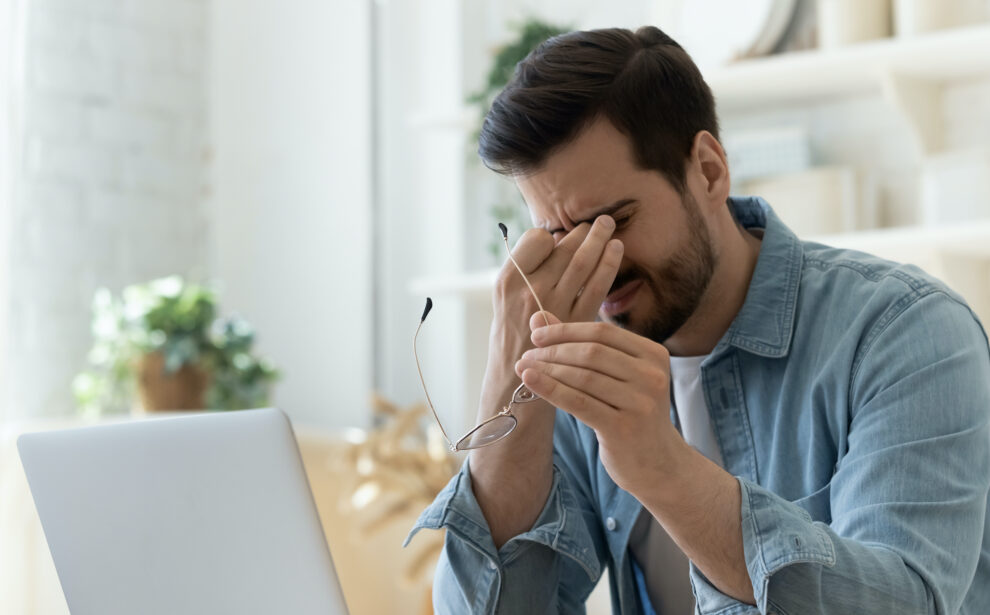
Dry Eye Syndrome
Are your eyes dry, itchy, or watery? These are some signs of a chronic eye condition called dry eye syndrome.
If you have dry eye syndrome, you’re not alone because it’s something millions globally suffer from. At Northern Utah Eye Center, our team of eye doctors, including Dr. Freeman, is here to help you improve your dry eye symptoms and find the relief you need.
What is Dry Eye Syndrome?
Dry eye syndrome is a chronic condition that happens when the eyes cannot produce sufficient moisture. To have healthy tears, you must also have a healthy tear film.
The tear film has three components: a water layer, a mucous layer, and an oil layer. If any of the three layers are missing, the balance of the tears is incorrect. The tears will not provide sufficient nutrients to the eye to keep it moisturized and well-lubricated. You may experience debilitating symptoms like dryness, watering, foreign body sensation, grittiness, or many others.
Causes of Dry Eye Syndrome
Dry eyes occur because not enough tears are produced, or the tears produced are low in quality. Other causes of dry eye syndrome include:
You may notice symptoms worsening over time if you have dry eye syndrome. If left untreated, dry eyes can cause corneal abrasions or scarring.
What are the Symptoms of Dry Eyes?
If you have dry eye syndrome, you may suffer from symptoms like:
Those with dry eye syndrome may only experience a few of these symptoms, or they may experience more. This is unique to each patient and depends on the root cause of your dry eyes.
Treating Dry Eyes at Northern Utah Eye Center
Northern Utah Eye Center offers many options for treating patients with dry eye syndrome. Dr. Freeman will help determine the root cause of your symptoms. Treatment options that patients may receive include:
Restasis
Restasis is a prescription eye drop used to treat chronic dry eye. The eye drop helps increase tear production to help improve your eye’s natural ability to produce tears.
Xiidra
Xiidra is a prescription eye drop for patients with dry eyes. It targets a source of inflammation that can cause dry eye syndrome.
Serum Tears
Serum tears are autologous serum eye drops (ASED) that use a patient’s blood serum and dilute it with a solution to create a tear substitute unique to that patient. Serum tears are formulated to work specifically with your eyes and are clinically proven more effective than other traditional eye drops.
Tyrvaya
Tyrvaya is the first and only nasal spray that helps improve dry eye syndrome. With one spray per nostril twice a day, Tyrvaya helps activate your tear film production to increase the number of tears your body can create.
iTear100
The iTear100 device is a drug-free, medication-free way of treating dry eye syndrome. The device uses a gentle oscillating tip to activate the external nasal nerve from outside your nose.
The iTear100 device activates your natural tear production using the perfect amount of vibration without affecting other areas besides the external nasal nerve of the nose.
The iTear100 device is FDA-approved and prescribed by your eye doctor to provide dry eye relief at home in as little as 30 seconds.
Amniotic Grafts
If patients have severe dry eye syndrome, amniotic grafts may be used. Amniotic grafts use amniotic tissues to provide dry eyes with a protective and nourishing barrier.
They also help damaged corneal tissue regenerate and heal. The graft is placed directly on the eye and begins dissolving within a few days while providing regenerative and healing qualities.
The membrane and plastic ring used to affix the graft are removed from the eye a few days later.
Scleral Contact Lenses
Scleral contact lenses can be an excellent way of treating chronic dry eye syndrome. Scleral contact lenses are different than traditional contact lenses.
Scleral contact lenses help minimize irritation because they sit on the sclera rather than the cornea, which is already irritated due to dry eyes. These lenses also help provide consistent hydration to the eyes because they contain a liquid reservoir that cushions and protects the eye while reducing pain and irritation.
Scleral contact lenses can act as a barrier to shield the cornea and eye from outside elements, the eyelid, or other friction.
Lumenis Optilight IPL
Optilight is the first and only FDA-approved IPL treatment for dry eyes. It uses Lumenis’ patented Optimal Pulse Technology (OPT) to help manage dry eyes caused by Meibomian Gland Dysfunction (MGD).
Optilight can help in various ways, including reducing inflammation, decreasing tear osmolarity, restoring the meibomian glands’ functionality, and decreasing Demodex mites.
Meibomian Gland Expression
Meibomian gland expression may become necessary for patients with dry eye syndrome. The meibomian glands are the oil glands found along the edge of the eyelids that make the oil needed for healthy tear production.
Meibomian gland expression involves expressing meibum from the glands to clear blockages. Gentle pressure is applied to the eyelids to help meibum flow out from the glands. Expression may use a sterile cotton swab, forceps, or rolling paddle.
LipiFlow
Lipiflow is an advanced, non-invasive treatment offered at Northern Utah Eye Center to address dry eye syndrome. This innovative therapy utilizes thermal pulsation technology to effectively clear and rejuvenate blocked meibomian glands, providing lasting relief by improving the quality of the eye’s lipid layer.
Do you need relief from your dry eye symptoms? Schedule an appointment at Northern Utah Eye Center in Logan, UT!
